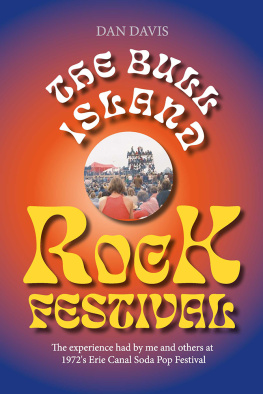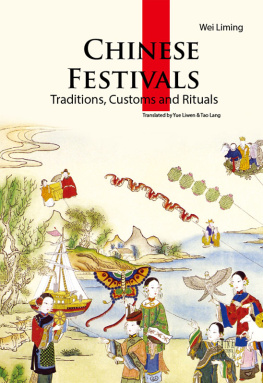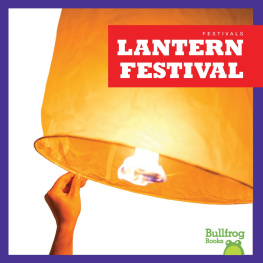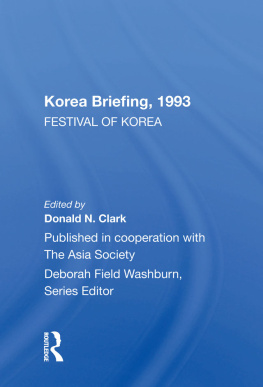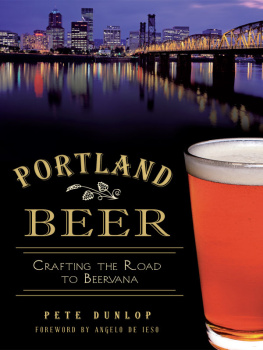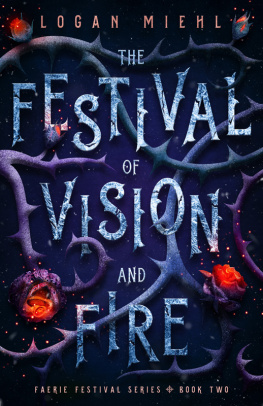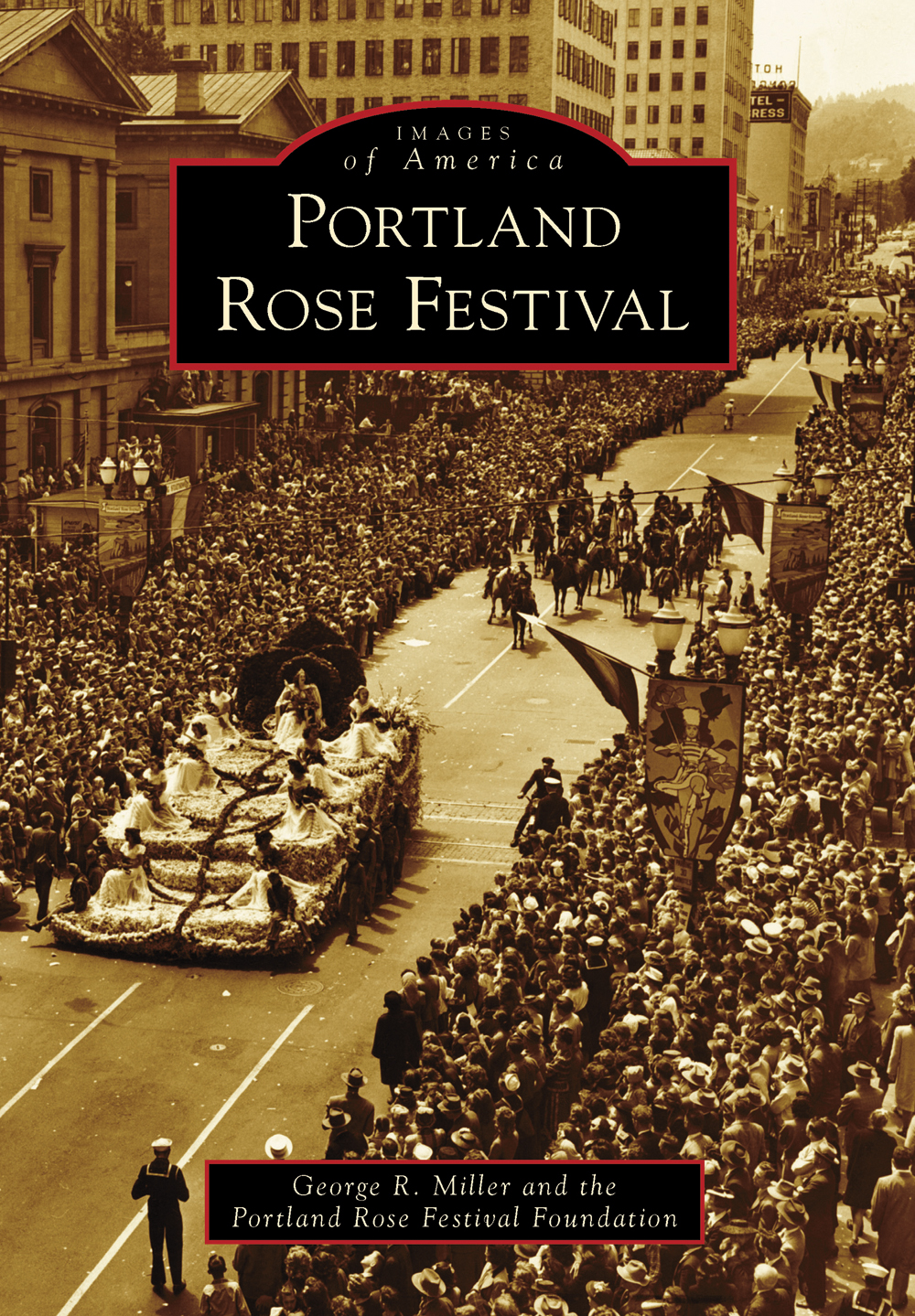
IMAGES
of America
PORTLAND
ROSE FESTIVAL

A horse-drawn float sits in front of the old Forestry Building in Northwest Portland, part of the 1905 Lewis & Clark Exposition and Worlds Fair. The Forestry Building, which burned down in 1964, was constructed of about 300 logs and dubbed the worlds largest log cabin. After the success of the exposition, Mayor Harry Lane decided the city should have an annual festival of roses, and the Rose Festival was born in 1907. (Courtesy the Oregonian.)
ON THE FRONT COVER: World War II halted all outdoor Rose Festival events, including the Grand Floral Parade. In 1946, after four years without a parade, eager spectators crowded the route so much that they hindered the forward motion of the entries. By 1947, an honor line was painted on the streets to hold people back, a system still used today. (Courtesy the Portland Rose Festival Foundation.)
IMAGES
of America
PORTLAND
ROSE FESTIVAL
George R. Miller and the
Portland Rose Festival Foundation

Copyright 2013 by George R. Miller and the Portland Rose Festival Foundation
ISBN 978-0-7385-9614-3
Ebook ISBN 9781439643235
Published by Arcadia Publishing
Charleston, South Carolina
Library of Congress Control Number: 2012940881
For all general information, please contact Arcadia Publishing:
Telephone 843-853-2070
Fax 843-853-0044
E-mail
For customer service and orders:
Toll-Free 1-888-313-2665
Visit us on the Internet at www.arcadiapublishing.com
This book is dedicated to the thousands of volunteers, supporters, sponsors, participants, and especially to the millions of spectators who have kept the festival flourishing.
CONTENTS
ACKNOWLEDGMENTS
So many individuals have worked closely with me on this book that it would be difficult to list everyone here. The Portland Rose Festival Foundation has given me access to its catalog of Rose Festivalassociated itemsfrom written documentation to countless photographsand without it this book would have been impossible. Chief operating officer Marilyn Clint, public relations manager Richard Jarvis, Rose Festival president Sue Bunday, and volunteer curator Nancy Benson Hopkins have been strong advisors to the author, and their knowledge of Rose Festival activities and community contacts were invaluable. Marilyn has lived, breathed, and worked for the Rose Festival more years than she can remember, and Nancy and Sue know more about Rose Festival history than this book could possibly contain. The Royal Rosarias, the official greeters to Portland, provided photographs. The Oregon Historical Society has also provided photographs and guidance; chief librarian Geoff Wexler, digital assets manager Scott Rook, and archivist Shawna Gandy have been invaluable. Several individuals have helped with proofreading the document, including my wife, Janice. As with every book I have written, Janice has proofread every word (several times) and has provided excellent suggestions. Finally, Arcadia Publishing associate editors Elizabeth Bray and Jared Nelson were there when I needed guidance. They have been excellent coaches. We have made every effort possible to identify people in the photographs.
INTRODUCTION
Several visionary leaders at the turn of the century are credited with the idea of starting the Rose Festivalmen like John Carroll and E.W. Rowe. In 1905, a worlds fair, the Lewis & Clark Exposition, which celebrated the centennial of the expedition of those famous explorers, was held in Portland with an estimated attendance of two million people. The fair was so successful (with revenue reported at $1.4 million) that the mayor of Portland, Dr. Harry Lane, made a speech at the close of the exposition calling for a permanent rose carnival to keep Portland on the map as the summer capital of the world.
The rose was selected as the theme for the festival because of its history and popularity locally and because it was a positive symbol that would take the emphasis off another indigenous Portland featurethe rain.
During the early years, the Rose Festival was known as many things, including Rose Carnival, Rose Show, Rose Fete, Rose Fiesta, and Feast of Roses. Following the first event in June 1907, a group of 10 businessmen formally organized the Portland Rose Festival Association as a nonprofit civic enterprise to plan and finance the annual event.
The Rose Festival took root, and the rest is history. Despite occasional financial woes and interruptions by a couple world wars, the festival marched on, literally and figuratively. Other organizations like the Royal Rosariansfounded in 1912rose up in support of the Rose Festival. Business leaders continued to be invested in the festivals governance, which evolved over a century into what is now known as the Portland Rose Festival Foundation. Today, the Rose Festival is a 501(c)3 nonprofit association run by a board of directors of up to 75 dedicated volunteers and a professional staff of 12 to 15. The modern Rose Festival is a leader in the special events industry, recognized for its innovative programming and top-notch events. In both 2007 and 2011, the Rose Festival was named the Best Festival in the World by the International Festivals and Events Associationthe trade organization for festivals and events worldwide.
The first Rose Festival lasted just three days. Today, the festival encompasses five weekends of celebration events, with a season that begins in March with the announcement of the Rose Festival Court. The court itself became a major feature of the festival in 1930, when princesses were first selected from local high schools. One of the earliest organizations in Oregon to offer scholarships to young women, the Rose Festival continues to emphasize the court, one of its most enduring programs. The court dominated the festival during World War II, when large outdoor eventslike paradeswere canceled by the US government.
The Rose Festival draws people to the Portland area from across the United States and around the world. Its most popular events are still its famous parades, including the iconic Grand Floral Parade, which annually draws more than 400,000 spectators to the streets of Portland. The more light-hearted Starlight Parade is the successor to the illuminated Electric Parade, or Merrykhana Parade, and attracts at least 250,000 people every year. The Junior Parade, which officially joined the festival lineup in 1936, is considered one of the largest childrens parades in the world, delighting thousands of children of all ages.
Over the years, events and programs have come and gone. In the 1920s, the Rose Festival offered its first air races, an event that returned on a large scale in the late 1980s as the Rose Festival Airshow. In the 1950s, the festival featured an arts festival, which reappeared on the schedule in the late 1990s. Balloon races, ski races, milk carton boat races, and road races of all description have been included in the festivals events. For 22 years, an Indy-style auto race was a highlight of the annual calendar. And the Rose Cup Races celebrated its 50th in 2011. Throughout its history, the festival has included a maritime element, attracting an annual fleet of ships from the US military and other countries around the world.
Tom McCall Waterfront Park in downtown Portland became the home of the Rose Festivals Fun Center in the 1970s. One of the festivals most popular events, this urban fair was reformatted and rebranded many times throughout the next three decades, and today, it emphasizes music, food, and carnival rides as Rose Festival CityFair. In 2009, the span of this event was stretched to include Memorial Day weekend, and a patriotic theme was added to the weekends activities.
Next page

